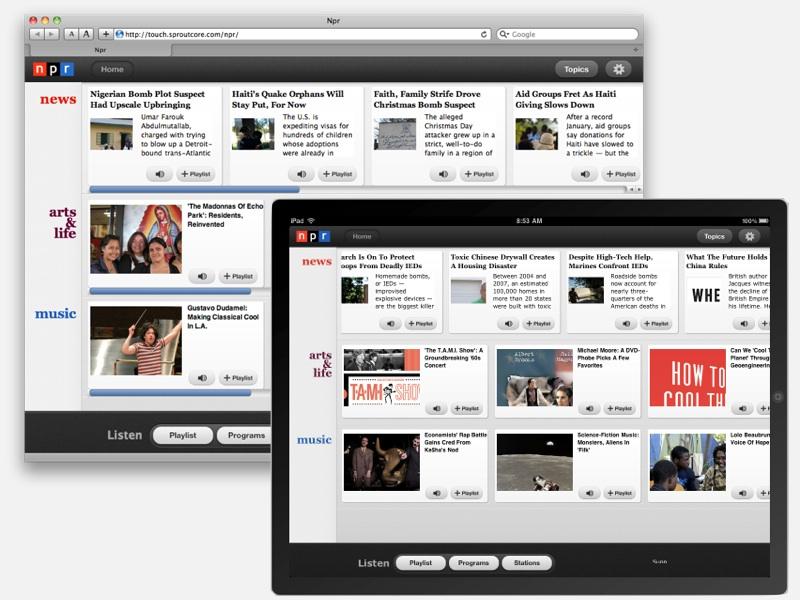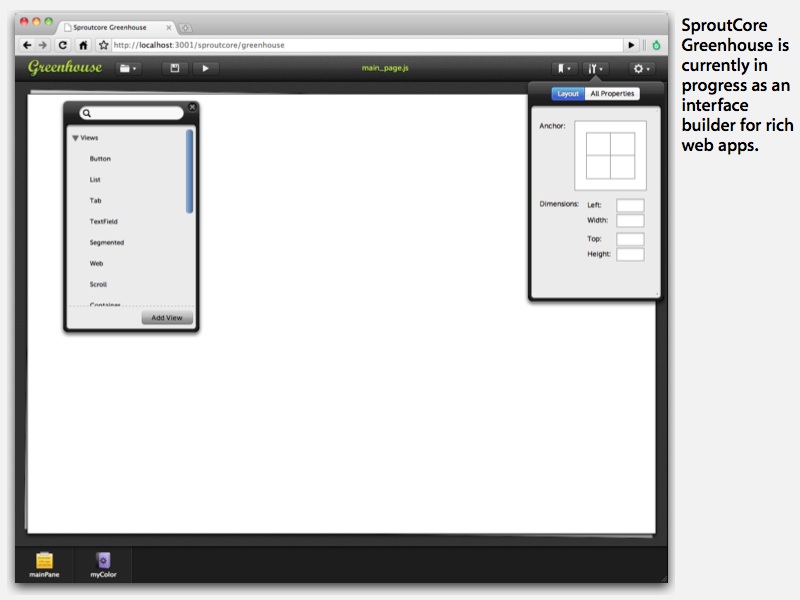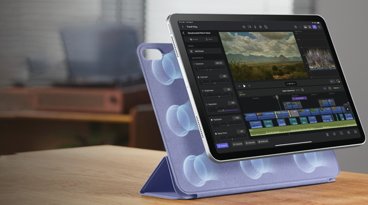Apple-backed SproutCore takes on Flash in race to deliver multitouch web apps
Among those using SproutCore to target the new market for such multitouch RIAs is Strobe, Inc., founded by Charles Jolley, the founder of SproutCore and until just recently a core developer of Apple's own SproutCore apps.
Jolley is now working both to advance SproutCore into the multitouch realm, and to promote solutions based on SproutCore that help publishers bridge the gap between desktop web apps and those aimed at running on touch-based devices.
"We're focused on helping companies transition their software from mouse-based desktops to touch mobile devices," Jolley said of his new Strobe startup in an email interview with AppleInsider. "We use a blend of HTML5 and native technologies that means the Strobe apps can be installed on your iPad or iPhone from iTunes App Store and accessed from and iPad or iPhone using Safari."
"Our first vertical is newspapers and online publishers. Right now we have a lot of interest from publishers - all household names. I will be sure to let you know as soon as I can announce something," he said. "My goal is to substantially grow the number of publications available on the iPad over the next year."
Solving the Flash problem
Many existing content developers are finding their existing proficiency in Adobe Flash to be worthless on the new iPad, which does not support Flash content. Adobe's own solution has been to create a native iPad app that simply flips users through a digital copy of existing print publications, a workaround used by Condé Nast to digitally publish Wired for iPad users.
The lack of strong alternatives to publishing content in Flash is creating a demand among publishers for tools that can help them transition to a future based on HTML5 and other open web technologies, creating content that will work on iPad and other touch-based mobile devices that support open web standards.
SproutCore developers recently demonstrated a web-based version of the native NPR iPad app (pictured below), which can now be viewed live online. That demonstration shows how sophisticated web apps are can now be, thanks to the SproutCore Touch framework.
Speaking of his new direction in building such tools, Jolley said, "Apple has been a life changing experience. It's not often you get to work with so many people so dedicated to building an amazing product. The products the company as put out over the last three years will transform the way we use computers for the next 15. Over the next few years most software and content companies will have to transition to touch devices. I think we can make that transition much easier with SproutCore, so I'm leaving Apple to focus on it."
The failure to Flash
The market for creating dynamic content for desktop web audiences has long been dominated by Adobe Flash. However, that company's inability to ship a suitable mobile version of its Flash Player for iPhone and other smartphone platforms over the last three years has resulted in Apple hitching itself to a faster new horse in the technology race: HTML5.
Adobe largely ignored Apple's decision until the unveiling of the Flash-free iPad this spring. As an instantly popular, multitouch tablet device, Apple's iPad appeared to be just what Adobe needed to propagate its Flash platform beyond the PC desktop. The problem is that much of the existing Flash content on the web would need to be reworked to support its exclusively multitouch interface; there's no mouse pointer or cursor control that nearly all existing Flash content assumes will be there.
Additionally, Apple has complained that the current Flash Player is not at all optimized for presenting either video or interactive content on mobile devices with significant engineering constraints related to battery life, available memory and processing capacity. Further, because Adobe owns Flash, Apple would have little control over how the technology evolved into the future, even if it joined Adobe's Open Screen Project, an initiative intended to help third parties port Adobe's Flash Player software to their platforms.
On page 2 of 2: A return to open web standards, RIAs, SproutCore aims at touch, tools.
At the same time, progress on HTML5 and related frameworks and web technologies has rapidly evolved as the IETF open standards for the web have been fleshed out and implemented by web browser developers.
Apple played a major role in making this happen by releasing both WebCore (based on the open KHTML web rendering engine) and then WebKit (Apple's higher level code used to build an actual web browser) as open source projects.
Nearly every smartphone platform has delivered a WebKit-based mobile browser, and Google has had significant success in bringing WebKit to the Windows PC with Chrome. And of course, Apple's own Safari is the default browser for Macs and its Mobile Safari variant drives the web in iOS iPhones, iPod touches, and iPads. This has immediately shifted the entire mobile web and a significant chunk of the consumer desktop web to WebKit, an HTML5-savvy platform Apple leads in conjunction with other contributors in the open source community.
WebKit's success has been joined by Firefox and Opera, and this high profile, broad support for HTML5 has even induced Microsoft to embrace HTML5 in its own Internet Explorer 9. This guarantees a far smoother future for web developers because HTML5 articulates how web standards must work in far greater detail than previous HTML specifications.
The emerging market for RIAs
HTML5 still does not do everything Flash does. By itself, HTML5 actually does very little to replace Flash other than making it unnecessary for web developers to rely upon Flash for web-embedded audio and video (via the new audio and video elements in HTML5), and to provide some tools for drawing and animating elements within web pages (such as HTML5 Canvas and CSS).
Recognizing this, Adobe has aimed Flash (and its related Flex) towards the emerging market for RIAs, rather than seeking to just hold on to Flash's mainstay of video distribution and simple animated web games.
RIAs can replace native apps, enabling "write once, run anywhere" deployment and allowing vendors to release embedded devices that don't need to depend upon Windows in order to run useful software. Google's upcoming Chrome OS for netbooks and tablets plans to incorporate support for Flash to allow tablet makers to run a collective of such RIA software directly from the web without needing to license Windows.
Adobe's proprietary Flash/Flex platform isn't the only option for delivering RIAs however. It competes rather directly against Microsoft's Silverlight, for example. But there are also a variety of other technologies for delivering RIAs without needing a third party runtime "player" plugin like those required by Adobe and Microsoft. Apple is staunchly behind SproutCore as one of them.
SproutCore aims at touch, tools
SproutCore Touch, a project aimed at targeting the SproutCore frameworks for use on touch-based devices, was introduced at JSConf in April. Its development continues with a first official version planned for delivery this fall.
Jolley added that, "by early 2011, we will have a new set of developer tools ready based on node.js that are much faster and include an interface builder [named Greenhouse, shown below]."
In addition to funding the development of SproutCore for building RIAs, Apple is also working on a variety of related development frameworks related to web standards:
- AdLib for iPad and PastryKit for iPhone have been described as "a visual effects library" for creating simple web apps with native appearance targeted at iOS devices. Apple uses it to build the web-based user manual installed as a bookmark on iOS devices.
- TuneKit is used to build the interactive menus for movie downloads (iTunes Extras) and bonus content created for music (iTunes LP), which playback from iTunes on a desktop PC or from Apple TV.
- Gianduia is a framework that adds Web 2.0-style rich interactivity to the client side of WebObjects. It's used by Apple Retail to create online apps for scheduling appointments and related tasks.
 Daniel Eran Dilger
Daniel Eran Dilger












 Andrew Orr
Andrew Orr
 Marko Zivkovic
Marko Zivkovic
 Malcolm Owen
Malcolm Owen
 Christine McKee
Christine McKee
 William Gallagher
William Gallagher
 Andrew O'Hara
Andrew O'Hara

 Sponsored Content
Sponsored Content






